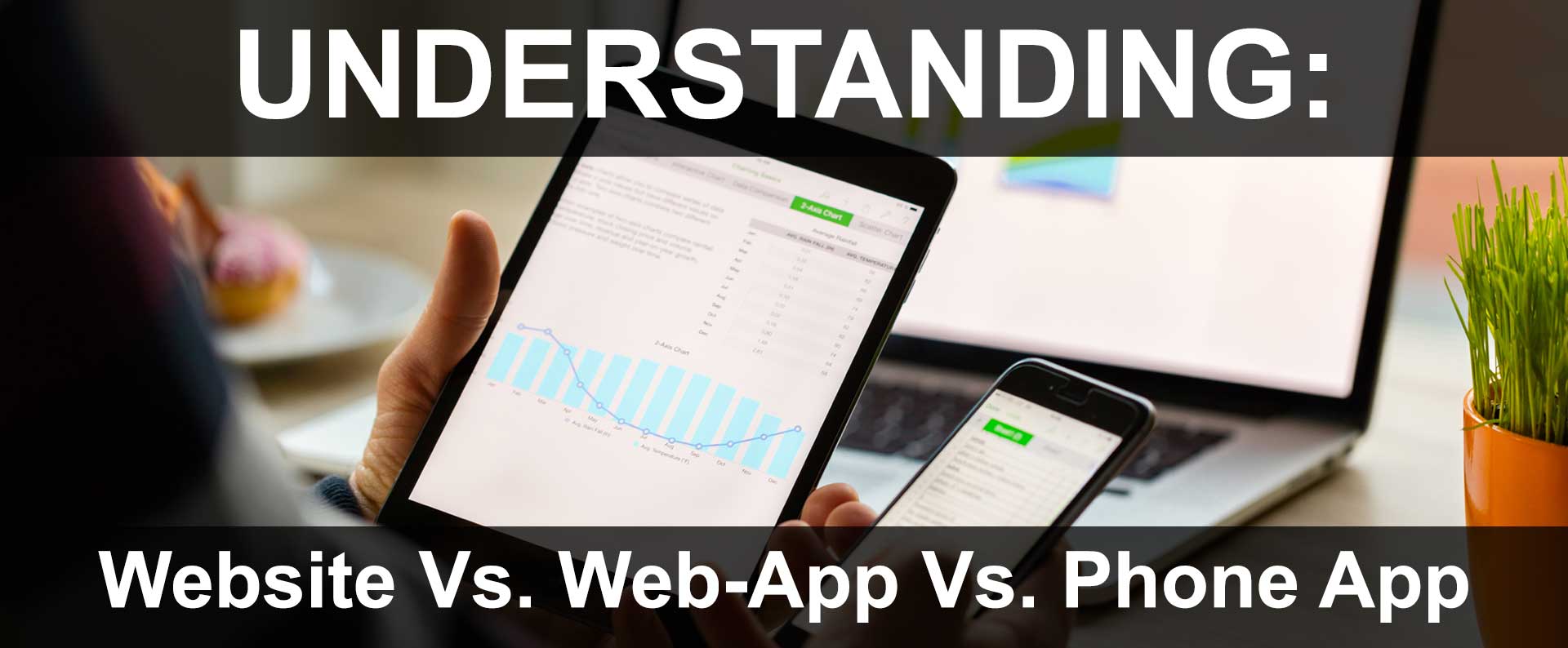Many people often wonder about the differences between a website, a web application, and a phone app. While these terms are sometimes used interchangeably, it's important to note that there are distinct differences and potential advantages and disadvantages for each, due to advancements in technology.
The Definition of a Website (The Beginning of Web 1.0)
The term website is often used broadly to refer to any place on the internet where visitors can access and navigate web pages containing data, text, images, audio, video, and other media through hyperlinks.
- A website can be static, allowing visitors to only read and view information, images, and other content. This is known as Web 1.0 technology.
- Alternatively, a website can be dynamic, enabling visitors to interact with the website and its data, thereby affecting the website's output; known as Web 2.0 technology.
In the past, websites (or Web 1.0 technology) lacked dynamic user interaction, only allowing users to view information or send information through forms. This was common from the mid-1990s to the early 2000s.
However, with advancements in technology, many websites today use what is known as Web 2.0 Technology. This allows for:
- interactive information sharing, as seen on social media platforms like Instagram, Twitter, and Facebook,
- as well as interactive functionalities like member profiles and e-commerce on sites such as PayPal, Amazon, and eBay.
These interactive websites are often referred to as "website applications".
Defining a Web Application (Growing Into Web 2.0)
A web application, often referred to as a website, is essentially a web-based software program that resides on a server computer connected to the internet, rather than on a user's personal computer.
Since the early 2000s, web applications have become as powerful as traditional software applications for home or business computers, but with added flexibility and dynamism.
Web applications are developed specifically for the internet, utilizing the latest Web 2.0 technology. This allows users to perform tasks that were previously impossible on traditional software applications installed on personal computers.
For example, Intuit, the company behind QuickBooks and TurboTax, utilized Web 2.0 technology to create web-based versions of their software programs.
Instead of purchasing and installing the software on a personal computer, users can now access these programs online through Intuit's servers from any computer with internet access.
Web Applications & Day-to-Day Business (A Web of Data Processed By Machines Web 3.0)
Over the past 20 years, the introduction of Web 2.0 technology and web applications has had a significant impact on all business, consumer, and retail markets. These technologies enable interactions and functionalities that were previously considered impossible for small businesses.
Web applications are now utilized for managing various aspects of business and communication, including website content through a CMS (Content Management System), customer records and notes through a CRM (Customer Records Management System), and customized online e-commerce shopping carts for managing orders and deliveries.
Custom web applications can be developed to fit specific business needs and manage data, similar to single PC-centric software programs. Additionally, web applications are fluid and web-based, allowing for constant modification and adaptation as business needs change.
Web 3.0 (known as the Semantic Web) represents the culmination of Web 2.0 technologies and focuses on machines managing and processing data gathered from the internet.
Mobile Web (A Revamp Web 4.0)
Google brought about "Mobilegeddon" back in 2015 and 2016 as the introduction of smartphones and tablets made the need for mobile-friendly and responsive websites crucial. This led to a revamp of websites to ensure they could be accessed and utilized on various devices, including desktops, laptops, tablets, and smartphones.
- Prior to responsive design, many websites were built strictly for desktop viewing; if a user wanted to view a website on their phone, they either had to pinch or stretch the screen to read content.
- If there was a "mobile-friendly" website for a phone, it was usually a separate-dumbed-down version of the main desktop site, lacking many features and functionalities.
Web 4.0 is not necessarily a new variation of the web with additional features, but rather an adaptation to the mobile reality and the need for users to access full websites and their features from any device.
This variation of the web aims to connect all devices in the real and virtual world in real-time spawning the Internet of Things (IoT).
Open, Linked & Intelligent Web (Symbiotic Web 5.0)
Web 5.0 is still evolving, but it appears to be a web that is linked and communicates with us, similar to how we communicate with others. This version of the web is expected to be powerful and fully executing, enabling read-write-execution-concurrency.
Web 5.0 is shaping up to involve emotional interaction between humans and computers. It is thought to be an autonomous, proactive, self-learning, and collaborative web.
The implications of Web 5.0 for society and humans at large are still being explored and understood by experts, but appears to be expanding the integration of VR (virtual reality) & AR (augmented reality) with everyday life.
AI (Artificial Intelligence Web 6.0)
Web 6.0, the current and ongoing version still in speculation, aims to create a semantic web where machines can understand and interpret the content available on the internet.
It is characterized by emotional, conscious, and creative web-applications generated and influenced by the user's emotions, moods, desires, and processed using affective computing and other emotional intelligence techniques.
The users can feel and express it in a more emotional and creative way. The main purpose of these web-applications is to connect the users and to inspire the web.
Smartphone Apps
While nearly every business today has a website, only a small number have developed smartphone apps. Phone apps are essentially software programs installed on smartphones and function similarly to traditional software programs on computers.
Most smartphone apps are platform-hardware centric, meaning they only run on specific devices like Apple's iOS or Google's Android. These apps can perform a wide range of tasks, from pulling in web data to processing and presenting it to users on their devices. Essentially, they are mini-computers running user-managed software programs.
While smartphone apps can leverage Web 1.0 - 3.0 technologies and perform powerful functions, they are limited to specific devices, unlike web apps that can be accessed on any full-HTML compliant device. The decision to develop a web app or a phone app depends on the needs of the business and its target audience.
For example, a phone app could be considered a benefit for users in certain instances by allowing the app to take advantage of device specific hardware features, such as GPS locating, cameras, microphones, etc; which may not be available via regular website applications in a regular browser.
On the other hand, phone apps are limited to specific devices such as Android or Apple; whereas web apps are capable of being accessed via most any full-HTML compliant device (most smart phones today), and will allow any user, on any platform, to access the website application.
The Take Away
Understanding the differences between websites, web applications, and phone apps is crucial in today's technology-driven world. Each offers unique advantages and disadvantages, and businesses must carefully consider their options based on their specific requirements and target market.
Weigh the pro's and con's to website apps versus phone apps based on the needs of the business and its clientele. Some industries may require both a web app, in addition to a smartphone app, based on their potential target market.













